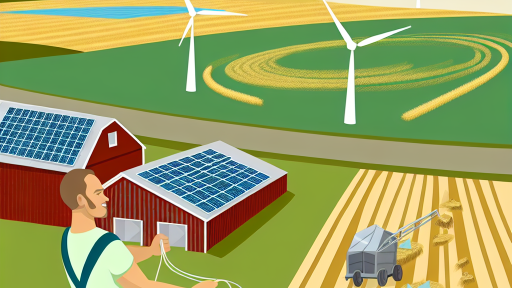Introduction to Climate-Smart Agriculture and Its Importance
Climate-smart agriculture addresses the challenges posed by climate change.
It enhances resilience while increasing productivity sustainably.
Farmers must adapt to changing weather patterns and extreme conditions.
This approach emphasizes sustainable practices that reduce greenhouse gas emissions.
For instance, implementing improved crop varieties helps increase yields.
Furthermore, crop diversification supports ecosystem health and resilience.
Climate-smart agriculture also focuses on efficient use of resources.
Using water-efficient irrigation techniques can mitigate drought impacts.
Additionally, promoting soil health can enhance carbon sequestration.
Farmers play a crucial role in reducing environmental footprints.
Governments should support policies that promote these practices.
Investment in research and development encourages innovation in agriculture.
Education and training programs improve farmer knowledge and skills.
Collaboration among stakeholders is essential for effective implementation.
Farmers, scientists, and policymakers must work together to achieve synergies.
Transform Your Agribusiness
Unlock your farm's potential with expert advice tailored to your needs. Get actionable steps that drive real results.
Get StartedEvidence-based strategies will guide the transition to climate-smart practices.
Ultimately, climate-smart agriculture benefits food security and livelihoods.
By adopting these methods, communities can thrive despite climate uncertainties.
Overview of Policy Frameworks Supporting Climate-Smart Agriculture
Defining Climate-Smart Agriculture
Climate-smart agriculture aims to enhance resilience against climate change.
This approach integrates practices that increase productivity sustainably.
Furthermore, it helps reduce greenhouse gas emissions in the agricultural sector.
International Policy Initiatives
Several global frameworks guide climate-smart agricultural practices.
The Paris Agreement emphasizes the need for sustainable practices in agriculture.
Moreover, the United Nations Sustainable Development Goals promote food security.
These initiatives prioritize climate resilience and sustainable land use.
National Policy Examples
Countries adopt various policies to promote climate-smart agriculture.
For instance, the United States Department of Agriculture supports innovative techniques.
Programs like the Environmental Quality Incentives Program offer financial assistance.
Similarly, Canada encourages climate adaptation through its Agricultural Climate Solutions program.
Research and Innovation Support
Research plays a crucial role in developing climate-smart practices.
Governments fund research to optimize resource use in agriculture.
Additionally, public-private partnerships drive innovation in this field.
For example, organizations like the International Food Policy Research Institute focus on data-driven solutions.
Incentives and Financial Support
Financial incentives encourage farmers to adopt climate-smart practices.
Subsidies for efficient irrigation and crop rotation help reduce environmental impact.
Moreover, grants for technologies that enhance productivity are available.
These financial tools support farmers in transitioning to sustainable methods.
Capacity Building and Education
Training programs are essential for implementing climate-smart agriculture.
These programs educate farmers on sustainable practices and resource management.
Showcase Your Farming Business
Publish your professional farming services profile on our blog for a one-time fee of $200 and reach a dedicated audience of farmers and agribusiness owners.
Publish Your ProfileFurthermore, community-based initiatives foster knowledge exchange among farmers.
Organizations provide workshops and resources to enhance skills and awareness.
Monitoring and Evaluation Frameworks
Effective monitoring ensures the success of climate-smart policies.
Governments establish benchmarks to measure progress and effectiveness.
Moreover, stakeholder engagement is critical for real-time feedback.
Regular evaluation helps in adjusting strategies and improving outcomes.
Strategies for Enhancing Soil Health and Fertility
Importance of Soil Health
Soil health is crucial for sustainable agriculture.
Healthy soil supports diverse ecosystems.
It improves crop productivity and resilience.
Moreover, healthy soil helps in carbon sequestration.
Organic Matter Management
Incorporating organic matter enhances soil structure.
Organic matter includes compost, manure, and cover crops.
These materials improve nutrient availability and water retention.
Additionally, they support beneficial microorganisms.
Crop Rotation Practices
Implementing crop rotation enhances biodiversity.
Diverse crop cycles reduce pests and diseases.
This practice builds soil fertility naturally over time.
Furthermore, it minimizes the need for chemical inputs.
Cover Cropping Techniques
Cover crops protect soil during off-seasons.
They prevent erosion and nutrient leaching.
Cover crops also suppress weeds effectively.
Moreover, they can fix nitrogen in the soil.
Soil Testing and Amendments
Regular soil testing informs nutrient management.
It identifies deficiencies and excesses in soils.
Based on results, appropriate amendments should be applied.
Corrective measures may include lime or fertilizers.
Minimizing Soil Disturbance
Reducing tillage preserves soil structure and biology.
No-till farming enhances water infiltration and retention.
This practice helps maintain organic matter levels.
Consequently, soil can better support crops.
Water Management Strategies
Efficient water management supports soil fertility.
Techniques like drip irrigation conserve water resources.
Proper drainage enhances soil aeration and root growth.
Additionally, this practice prevents soil salinization.
Agroforestry Integration
Integrating trees in farming systems benefits biodiversity.
Trees improve soil health through nutrient recycling.
They also provide shade and wind protection for crops.
Such systems support diverse habitats for wildlife.
Knowledge Sharing and Education
Promoting education on soil health is vital.
Farmers can adopt best practices through workshops.
Showcase Your Farming Business
Publish your professional farming services profile on our blog for a one-time fee of $200 and reach a dedicated audience of farmers and agribusiness owners.
Publish Your ProfileCollaboration with local agricultural experts benefits all.
Community engagement fosters a culture of sustainable practices.
You Might Also Like: Complying with Animal Welfare Regulations: A Farmers Guide
Water Management Policies for Resilient Agricultural Systems
Importance of Water Management
Water is a crucial resource for agricultural productivity.
Effective water management enhances crop yields and farmer income.
Moreover, it mitigates the effects of drought and water scarcity.
Farmers benefit significantly from well-planned water strategies.
Implementing Strategic Policies
Governments should prioritize water management policies.
These policies must focus on sustainable use of water resources.
Furthermore, policies should include incentives for water conservation.
Farmers can adopt techniques such as rainwater harvesting.
Innovative Irrigation Techniques
Modern irrigation systems improve water efficiency.
Drip irrigation, for example, minimizes water wastage.
In addition, smart irrigation technologies help monitor water usage.
Such innovations lead to sustainable practices among farmers.
Collaboration with Local Communities
Engaging local communities is vital for effective implementation.
Farmers can share best practices and learn from each other.
Community involvement fosters a sense of ownership and accountability.
Moreover, partnerships with NGOs can boost support for water initiatives.
Monitoring and Assessment
Regular assessments ensure policies remain effective over time.
Data collection helps identify areas needing improvement.
Monitoring systems can track water quality and availability.
Informed decisions can then be made to enhance agricultural resilience.
Learn More: Nutrient Management Standards for Farms
Promotion of Agroforestry and Biodiversity in Agricultural Practices
Understanding Agroforestry
Agroforestry integrates trees and shrubs into farming systems.
This approach enhances biodiversity on agricultural lands.
Farmers can benefit from multiple products and income sources.
Moreover, agroforestry improves soil health and fertility.
By capturing carbon, it also mitigates climate change effects.
Benefits of Biodiversity in Agriculture
Biodiversity contributes to stable agricultural ecosystems.
Diverse species can enhance crop resilience against pests and diseases.
This diversity allows ecosystems to adapt to changing conditions.
Furthermore, it promotes pollination, essential for many crops.
Implementing Agroforestry Practices
Farmers can start by selecting suitable tree species.
These should complement existing crops and local conditions.
Training and resources must be provided to the farmers.
Collaboration with local agricultural organizations aids in this process.
Encouraging Policy Support
Governments should develop incentives for agroforestry practices.
Financial assistance can encourage farmers to adopt sustainable methods.
Moreover, training programs can educate farmers on best practices.
Showcase Your Farming Business
Publish your professional farming services profile on our blog for a one-time fee of $200 and reach a dedicated audience of farmers and agribusiness owners.
Publish Your ProfilePolicies promoting biodiversity can enhance ecosystem services.
Roles of NGOs and Communities
Non-governmental organizations can facilitate agroforestry projects.
They play a crucial role in mobilizing resources and expertise.
Community involvement strengthens the implementation process.
Collaborating with local farmers ensures practices are culturally relevant.
Discover More: Wind Energy Incentives: Opportunities for Agricultural Operations

Incentives for Farmers to Adopt Climate-Smart Technologies
Financial Support Programs
Governments can provide financial assistance to farmers for adopting climate-smart technologies.
Subsidies can lower the cost of equipment and technology, making them more accessible.
Additionally, grants can fund research and development for innovative solutions.
These financial programs can greatly enhance farmers’ willingness to transition.
Training and Education Initiatives
Farmers need training to effectively implement climate-smart practices.
Educational workshops can teach sustainable agricultural techniques and technologies.
For instance, programs by local agricultural extension services can be valuable resources.
Further, online courses can reach a wider audience and cater to diverse learning styles.
Market Access and Incentives
Creating markets for sustainably produced goods encourages climate-smart farming.
Sustainable certification programs can help farmers access premium markets.
Furthermore, consumers are increasingly willing to pay more for eco-friendly products.
This consumer trend can enhance the profitability of climate-smart practices.
Policy and Regulatory Support
Governments should create supportive policies that promote sustainable agriculture.
This can include regulatory frameworks that incentivize climate-smart practices.
Tax breaks and reduced fees for environmentally friendly operations can motivate farmers.
Moreover, collaboration between government and farmers can create effective policies.
Collaboration with Private Sector
Private sector partnerships can drive the adoption of climate-smart technologies.
They can offer financing options that lessen the burden on individual farmers.
Additionally, tech companies can provide farmers with innovative solutions and systems.
This collaboration can lead to the development of tailored programs that meet farmers’ needs.
Uncover the Details: Tailoring Agricultural Insurance to Your Farming Needs
Role of Research and Innovation in Developing Climate-Smart Strategies
Importance of Research in Agriculture
Research plays a crucial role in advancing agriculture practices.
It helps identify effective methods for sustainable farming.
Moreover, research addresses challenges posed by climate change.
Innovative solutions arise from detailed scientific investigation.
These solutions enhance resilience and productivity in farming.
Innovation as a Driver of Progress
Innovation stimulates growth in the agricultural sector.
It introduces new technologies that improve efficiency.
For example, precision agriculture optimizes resource use.
This technique reduces waste and maximizes yields.
Furthermore, innovative crop varieties withstand climate stresses better.
Collaboration Between Researchers and Farmers
Collaboration fosters a strong link between research and practice.
It ensures that innovations meet real-world needs.
Farmers provide insights that guide relevant research efforts.
Showcase Your Farming Business
Publish your professional farming services profile on our blog for a one-time fee of $200 and reach a dedicated audience of farmers and agribusiness owners.
Publish Your ProfileMoreover, researchers can tailor solutions to local conditions.
This partnership enhances the success of climate-smart strategies.
Funding and Support for Research Initiatives
Funding is vital for supporting agricultural research projects.
Government grants and private investments drive innovation.
Additionally, public-private partnerships can amplify resources.
With adequate funding, projects can scale effectively.
Ultimately, this investment advances climate-smart agriculture.
Integrating Technology and Traditional Knowledge
Integrating new technology with traditional practices yields benefits.
Farmers’ historical knowledge informs modern agricultural techniques.
This approach respects cultural practices while enhancing productivity.
As a result, communities maintain food security amid climate challenges.
Synergy between innovation and tradition ensures sustainability.
Engagement and Education for Stakeholders in Climate-Smart Practices
Identifying Key Stakeholders
Identifying key stakeholders is essential for effective engagement.
Farmers, policymakers, researchers, and consumers all play vital roles.
Understanding their unique perspectives helps tailor educational efforts.
Developing Targeted Educational Programs
Targeted educational programs can drive effective engagement.
These programs should address specific needs and challenges.
For instance, workshops can help farmers adopt new techniques.
Online resources can provide ongoing support and information.
Interactive forums foster discussion and exchange of ideas.
Utilizing Local Knowledge and Resources
Leveraging local knowledge enhances program relevance and effectiveness.
Local experts can share practical experiences with climate-smart practices.
Community engagement can build trust and foster collaboration.
Implementing Feedback Mechanisms
Feedback mechanisms ensure continuous improvement in educational efforts.
Surveys can gather stakeholder insights on program effectiveness.
Adjusting programs based on feedback enhances engagement outcomes.
Promoting Collaborative Learning
Collaborative learning encourages knowledge sharing among stakeholders.
Partnerships can amplify the reach and impact of educational initiatives.
Events such as field days can showcase successful practices in action.
Measuring Impact and Success
Measuring impact is crucial to gauge the effectiveness of engagement strategies.
Establishing clear metrics helps assess improvements in practices.
Tracking progress can guide future initiatives and investments.
Additional Resources
U.S. Agricultural Policy Review, 2022 | Economic Research Service
USDA Requests Information on USDA’s Climate-Smart Agriculture …




